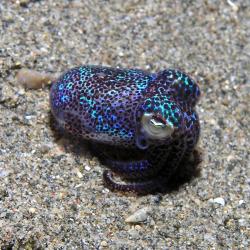Source Institutions
Source Institutions
Add to list Go to activity
Activity link broken? See if it's at the internet archive

In this four-part activity, learners will discover the exciting world of light--the most important form of energy in our world--and be able to identify and describe different types of light. Learners examine incandescence and luminescence, fluorescence and phosphorescence, chemiluminescence, and bioluminescence. These light phenomena can be applied to the study of oceans.
- 5 to 10 minutes
- 1 to 2 hours
- Over $20 per group of students
- Ages 11 - 14
- Activity, Experiment/Lab Activity, Lesson/Lesson Plan
- English
Quick Guide
Materials List (per group of students)
- A somewhat dark room
- Lamp with incandescent (filament) light bulb (your average, run of the mill bulb)
- 1 Light Stick --any color
- Fluorescent clay or other fluorescent material (may substitute with highlighter on paper)
- Phosphorescent stars or glow in the dark paint
- Red flashlight
- UV or Black light
- 2 Green light sticks
- 2 Clear glasses large enough to submerge light sticks: one filled with ice water (labeled) and one filled with hot water (labeled)
- Pyrocystis fusiformis dinoflagellate culture
- Small dish or cup to hold culture
- Coffee stir stick
- Microscope and depression slide (optional)
Subjects
-
Earth and Space Science
-
Earth Structure
- Oceans and Water
-
Earth Structure
-
Life Sciences
-
Diversity of Life
- Animals
-
Diversity of Life
-
Physical Sciences
-
Chemistry
- Chemical Reactions
- Chemistry of Life
-
Vibration and Waves
- Wave Properties
-
Light and Optics
- Sunlight and Color
-
Chemistry
-
The Nature of Science
-
The Scientific Process
- Conducting Investigations
-
The Scientific Process
Informal Categories
- Animals
- Nature and Environment
Audience
To use this activity, learners need to:
- see
- see color
- read
- touch
Learning styles supported:
- Involves hands-on or lab activities
Other
Includes alignment to state and/or national standards:
This resource is part of:
Access Rights:
- Free access
By:
- COSEE Florida
Rights:
- All rights reserved, Centers for Ocean Sciences Education Excellence, 2012
Funding Sources:
- National Science Foundation, 0827983
- National Science Foundation, 0828142
- National Science Foundation, 0827953
- NOAA National Sea Grant
- Office of Naval Research
- National Oceanic and Atmospheric Administration
